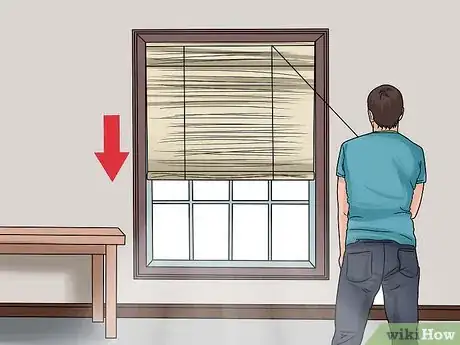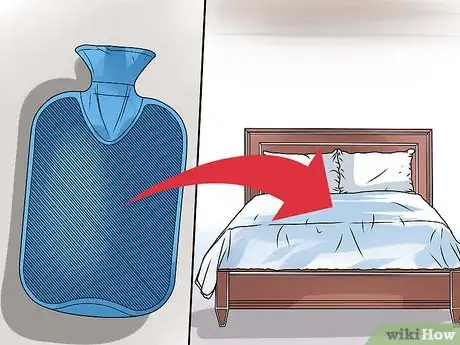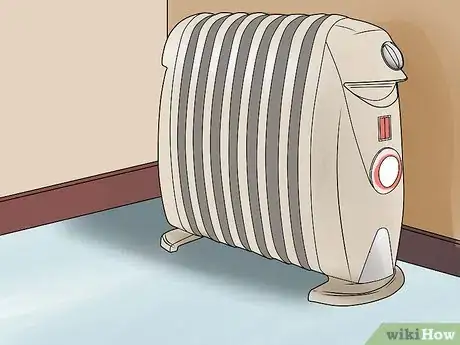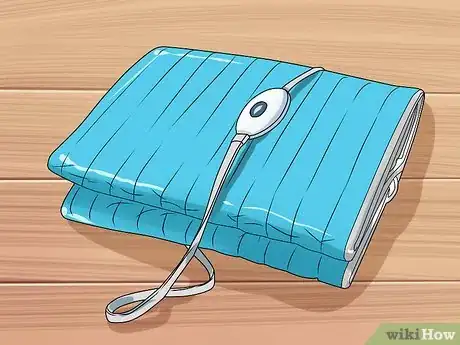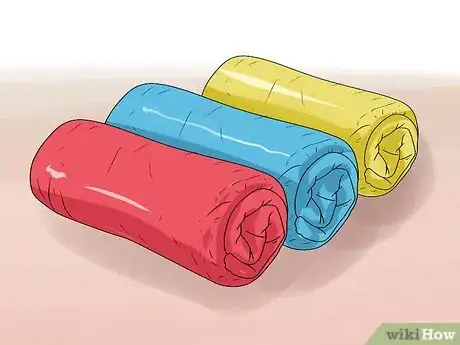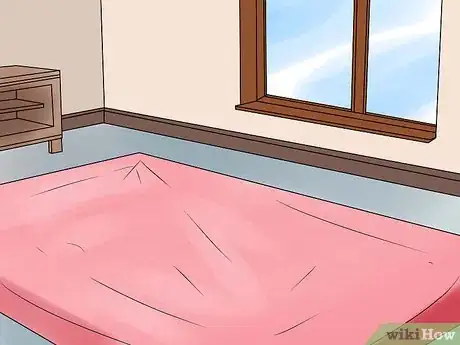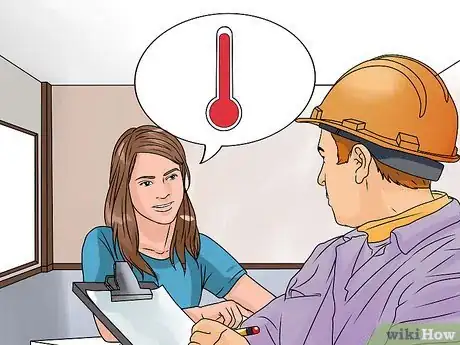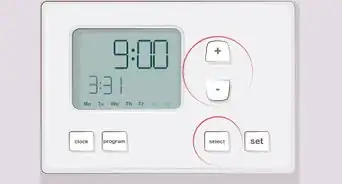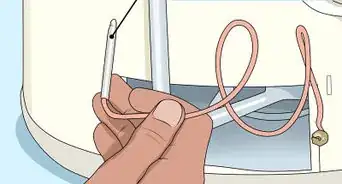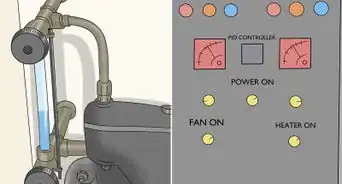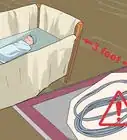wikiHow is a “wiki,” similar to Wikipedia, which means that many of our articles are co-written by multiple authors. To create this article, 32 people, some anonymous, worked to edit and improve it over time.
This article has been viewed 347,591 times.
Learn more...
Are you unable to get to sleep at night because your room is freezing? Sick of shivering as you get ready for work or school in the morning? Chatter your teeth no longer — no matter how cold it is outside, it's almost always possible to make a room warmer with a few simple tricks! Best of all, many of these can be done for free or quite cheap, giving you warm, cozy comfort without burning cash.
Steps
Cheap or Free Solutions
-
1Use your windows and blinds to warm your room with sunlight. One of the easiest ways of all to keep your room warmer is to use the sun, mother nature's original space heater. In general, you'll want to allow as much warm sunlight into your room as possible during the day and to prevent that warmth from leaving at night. For best results, you'll also need to know which windows in your room the sun shines through — generally, these are south-facing windows in the Northern Hemisphere and north-facing windows in the Southern Hemisphere.[1] Here's simple sample schedule you may want to use:
- Morning: Before you leave for work or school, close all of your room's windows. Open the blinds all the way.
- Afternoon: Leave your blinds open until sun stops shining into your room. As soon as it starts to get dark and cold, close the blinds.
- Night: Keep the blinds and windows closed throughout the night to preserve heat.
-
2Wear layers for energy-free heating. In a world where the climate impact of household practices is becoming a bigger concern, many environment-conscious consumers are choosing to heat the person, not the room. Wearing a coat, a jacket, or some sweat pants indoors is a great way to stay warm without using an ounce of heating energy (or spending a penny on your heating bill.)
- If your room is especially cold at night, you might try wearing layers at night. Though some people find this uncomfortable, soft garments like sweatpants and "hoodie" sweatshirts usually give the most warmth without sacrificing much comfort.
- Artificial fabrics that don't "breathe" like polyester, rayon, and so on generally trap the most heat (this is why they're so uncomfortable in the summer).
Advertisement -
3Put hot water bottle in your bed. One of the worst feelings in the world is navigating an ice-cold room in your pajamas only to slide into a sub-zero bed. While your bed should heat up once you're in it, you can avoid this awful feeling by heating it up before you get in. A hot water bottle is one great way to do this — simply fill it with steaming water, close the lid tight, and leave it in the center of your bed under the covers 15 minutes before you go to bed.. As it cools, it will dissipate heat into your bed, leaving it nice and toasty when you get in.
- Medical water bottles are available at many pharmacies for around $15 or less.
- If you're using a microwave to heat your water, be sure to use a microwave-safe container (like a glass or ceramic bowl).
-
4Plug drafts with spare blankets. The last thing you want when you're trying to heat a room is a draft (sometimes spelled "draught"), a spot where cool air can leak into the room. Keep any drafts plugged up with spare rags or blankets while you're waiting for a more permanent solution (like replacing a leaky window, etc.) When drafts are especially bad, this simple fix can make a big difference.
- Not sure whether you have a draft? There are several ways to discover them. One is simply to hold your hand near a crack in a window or door and feel for the motion of air. You can also use a candle — if its flame flickers near a crack, you have a draft.
- Try the U.S. Government's draft-detecting tips at energy.gov for more ideas.
-
5Make the most of existing heaters or radiators. Do you have a heater or radiator in your room that doesn't seem to be making a difference when it comes to keeping you warm? Use these tips to increase their effectiveness (and save you money you'd otherwise be wasting):
- Make sure there are no pieces of furniture between the heater or radiator and yourself. For instance, many older houses hide radiators behind couches.
- Put a sheet of tinfoil behind a radiator (use a sheet about the same a size as the radiator itself). This reflects heat that would normally be transmitted into the wall, heating the rest of the room.
- If your heater is portable, use it in the smallest space possible so that it can most effectively heat you. For instance, a space heater will heat a small bedroom much better than it will heat a large living room.
-
6Invite people into the room. It's easy to forget that human beings are essentially walking, talking, biological furnaces, constantly emitting heat into the air around them. Bringing an extra person or two into the room can make a noticeable distance — your combined body heat and the heat of your exhalation will help warm the room.
- Two things are important to keep in mind with this method: the smaller the room and the more physically active the people in it, the warmer it will get. In other words, a lively party in a small room will produce a lot more heat than a few people sitting on couches in a large living room.
- If your friends are busy, even pets can make a room a little warmer (unless they're cold-blooded — fish and lizards aren't helpful here).
-
7Get a hair dryer and lightly blow the bed with the dryer. This trick may seem a little ridiculous, but it does work. After all, a hair dryer is essentially a small space heater with a fan in it. You can blow hot air directly onto your bed or lift up the covers and point the hairdryer underneath to create a pocket of warm air for you to lie in.
- Be careful not to touch the hot metal elements at the end of your hair dryer with your bedsheets, especially if they're made of a fabric that's prone to melting (like polyester, etc.)
More Expensive Solutions
-
1Get a space heater for your room. Obviously, if you don't already have a heater, you may want to consider buying one. Plug-in heating devices, which can usually be found at most department stores, are available in a wide range of sizes and power levels, making them a reasonable solution for any size room (and any budget).
- Keep in mind that space heaters tend to use a lot of electricity. While you may be able to make up the difference by turning off your central heating, frequent space heater use can affect your utility bill.
- Always adhere to the basics of heater safety: don't leave space heaters on unattended (including while you sleep) and don't use space heaters that burn fuel indoors, as these pose a carbon monoxide hazard.[2]
-
2Get an electrical blanket for your bed. Though they were once considered unfashionable, electrical blankets are making a comeback thanks to the comfort (and savings) they provide. The devices can make for an exceptionally comfortable slumber when it's cold in your room. Best of all, they tend to use significantly less energy than other plug-in heaters — one consumer study found that they usually saved about one-half to three-fourths of the energy.
-
1
- For the most comfort, start the electric blanket a few minutes before you get into bed. To save energy, turn it off before you fall asleep.
-
2Get more blankets. For some, there's nothing quite as comfortable as the feeling of being under a heavy pile of blankets when it's cold. The more layers of blankets you use, the more of your body heat will be trapped in the bed. Additional layers create pockets of "dead heat" — air that has a hard time leaking out into the surrounding cool.
- In general, thicker, fluffier materials (like wool, fleece, and down) are warmest. Air gets caught in the tiny spaces in these materials, trapping more heat next to the body.
- Don't forget that you can even wear blankets around the house — perfect when you don't want to give up the warm comfort of bed just yet.
-
3Get thicker curtains. Windows are one of the most frequent sources of heat loss for rooms. To counteract this, try hanging thick, heavy curtains around your window and closing them as soon as it starts to get cold in the evening. The heavy material of the curtains will help slow the heat loss through the glass, keeping the room warmer, longer.
- If curtains aren't in your budget, you can get a similar effect by hanging old blankets in front of windows.
-
4Cover bare floors (and walls.) Smooth, hard surfaces like wood, tile, and marble tend to retain much less heat than carpet. In fact, un-insulated floors can account for 10% of a room's total heat loss.[3] If you're tired of freezing your toes off when you get up in the morning, consider laying down a rug or even having carpeting installed. This will also help keep your room warm once you've heated it — a carpeted room will stay warm longer after you turn off the heater than a room with a bare tile floor.
- You can even sometimes get away with covering some of your walls with carpet-like materials to increase this effect. Things like tapestries and decorative rugs can look great when they're hung from the wall and can keep your room slightly warmer at the same time.
-
5Invest in better insulation. Though it's a major investment, getting new insulation in your home can be a project that pays for itself in the long run, as this can dramatically reduce heating bills (especially for older, draftier houses). Another benefit, of course, is that you'll be warmer and more comfortable. Below are a just few types of insulation you may want to consider:
- Wall insulation (fiberglass, etc.)
- Window insulation (double and triple-paned windows, protective films, etc.)
- Door insulation (draft guards, floor seals, etc.)
- Every house is different, so the amount of work required can vary wildly from house to house. Before you make any concrete decisions, talk to an experienced contractor (or several) and get an estimate for your project so you can determine what the best decision for you is
Community Q&A
-
QuestionWould putting a fan next to the radiator be a good idea?
 Community AnswerYes. The warm air would be able to circulate easier, which would provide the room with more heat.
Community AnswerYes. The warm air would be able to circulate easier, which would provide the room with more heat. -
QuestionWould turning on a light help?
 Community AnswerLight bulbs wouldn’t be strong enough to give off enough heat for you to actually notice a difference in temperature.
Community AnswerLight bulbs wouldn’t be strong enough to give off enough heat for you to actually notice a difference in temperature. -
QuestionWhat can be done to heat a room without using appliances?
 Community AnswerCurtains are a good start. If you have thicker curtains on your windows, it will trap heat in the house at night, making it warmer. Putting a rug down if the floor is wood is another good option. The rug traps heat, also making the room warmer.
Community AnswerCurtains are a good start. If you have thicker curtains on your windows, it will trap heat in the house at night, making it warmer. Putting a rug down if the floor is wood is another good option. The rug traps heat, also making the room warmer.
Warnings
- Be careful not to burn yourself with any radiator, heater, or hot water bottle you use.⧼thumbs_response⧽
Things You'll Need
- Warm clothes
- Heater
- Blanket
- Something warm to drink
References
About This Article
To warm up a room, open your blinds or drapes during the day to let sunlight in. If you have a hard floor, cover it with rugs or a carpet, which retain more heat than smooth surfaces. You can also cover walls with tapestries and decorative rugs to preserve a little more heat. If you notice any drafts around your walls or windows, seal them up with filler, or use blankets for a temporary solution. Make sure any radiators or heaters in the room are uncovered to make the most of their heat. For even more heat, put a sheet of tinfoil behind the heater, which will reflect the warmth back into the room. For more tips, including how to make your bed warmer at night, read on!
